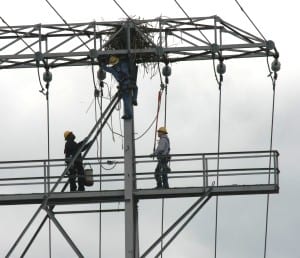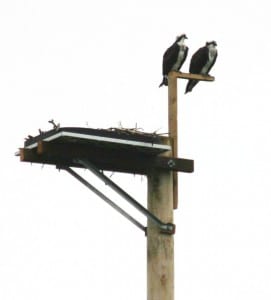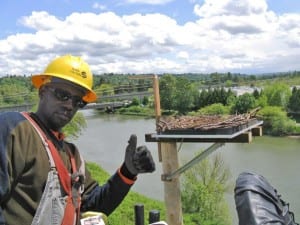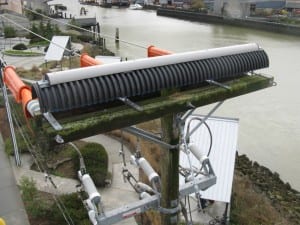 Osprey and electrical equipment don’t belong together, and City Light is working hard to separate the two.
Osprey and electrical equipment don’t belong together, and City Light is working hard to separate the two.

Seattle City Light workers remove an osprey nest near the Duwamish River that caused a short circuit.
Osprey and electrical equipment don’t belong together, and City Light is working hard to separate the two. But that is often easier said than done.
Take for example the City Light electrical towers near the Duwamish substation, near the waterway of the same name. For much of the past decade, City Light scientists, engineers and line workers have tried different creative ways to discourage the birds of prey from building nests on metal structures and utility poles.
The equipment makes attractive perches for osprey, falcons and other predatory birds, since much of their natural perching and nesting areas have disappeared. But utility poles and towers are inherently dangerous – high voltage lines are not insulated, and can arc current to any surface or structure offering a transmission channel, such as a stick, string, or an unfortunate bird.
The first prevention effort, building pole platforms at Harbor Island, Tukwila, and the Ship Canal to provide alternate nest sites for ospreys, has worked very well, with several pairs using them to lay their eggs and raise young.
However, the Duwamish location is also popular with bald eagles, and at least one pair is nesting in the area. Ospreys don’t care much for them, since they are opportunistic predators that steal the fish they bring home to their chicks. Possibly because of the new neighbors, the osprey pair stopped using the nest platform in 2012 and started building a nest on a tower across the river right next to feeder lines carrying 26,000 volts.
The osprey pair was not successful in nesting in 2013 but continued to add sticks to the electrical tower. As the size of the nest increased in late June, sticks came in contact with live wires and caused a power outage. Crews visited the nest site and since it did not have eggs or hatchlings, they removed the sticks. To prevent any further outages, they placed rubberized covers where the feeder lines and jumpers meet the cross arms.
“We are still looking at a long-term solution to preventing nesting on lattice tower cross arms,” said City Light Wildlife Biologist Ron Tressler.
City Light is considering adding additional covers and materials that make it difficult for osprey to perch and build nests where they can cause outages or be injured. One such device made of corrugated pipe was installed and tested in 2011 at another Duwamish pole. The utility also is monitoring the existing nesting platforms, to find ways to make them more inviting to osprey.
City Light and other utilities are required by the Migratory Bird Treaty Act, the Bald and Golden Eagle Protection Act, and the Endangered Species Act to find ways to prevent injury to wild birds. City Light has had a formal program for avian protection since 2007, recording bird strikes, training crews on how to deal with avian accidents, and crafting equipment tweaks to prevent accidents.


